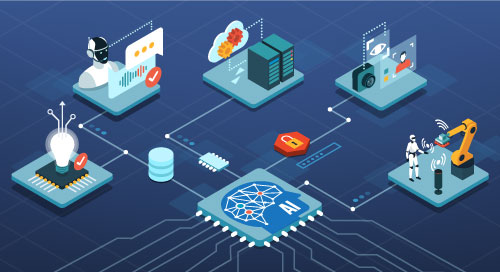Fill form to unlock content
Error - something went wrong!
Get the latest on IoT and network edge for retail.
You are following this topic.
Edge AI + IoT Solution Integrators Speed Time to Market

AI is the perfect example of a disruptive technology—and even established companies can take advantage of the digital transformation prospects that can bring.
For systems integrators (SIs) in particular, it is a time of unprecedented opportunity. In nearly every industry, SIs enjoy strong customer demand for AI-enabled digital transformation. But building an AI-enabled solution that’s market ready can be time- and labor-intensive.
“The AI product marketplace is extremely fragmented, and systems integrators lose a substantial amount of time sending their engineers out to look for all the different hardware and software elements to deliver a solution that meets spec,” says Allan Hia, South Asia Senior Director for WPG Holdings(WPG), an Intel® IoT solution aggregator that serves OT and IT SIs.
This poses a real problem for today’s SIs, who are under pressure to bring innovative AI solutions to market quickly—or risk being left behind.
Scalable, Repeatable Edge AI Solutions Speed Time to Market
In this difficult environment, full-service aggregators like WPG make it possible for SIs to enter the AI marketplace. With large footprints that span borders and industry verticals, aggregators can provide a number of unique benefits to their partners:
- Edge AI platforms that are fully integrated and tested, which can be purchased as easily as a component part.
- Access to new markets through an international network of solution providers and established business relationships with hard-to-reach end customers.
- A range of value-added services, including financing, training, logistics, and help with import/export in international markets.
#IoT solution aggregators deliver value to all parties involved in #DigitalTransformation, across multiple industries. WPG Holdings via @insightdottech
In short, IoT solution aggregators deliver value to all parties involved in digital transformation, across multiple industries.
“For SIs, the biggest benefit to working with a solution aggregator is that it speeds time to market,” says Hia. “It gives them access to repeatable solutions that have already been developed to the proof-of-concept stage or beyond.”
For hardware, software, and cloud technology providers, aggregators offer a way to scale, and help open doors and smooth operations in new markets. And end customers benefit as well. They get best-of-breed, AI-powered solutions that deliver positive business outcomes—without the need to invest in technology development.
SIs Benefit from Partner Ecosystems
A good example of how aggregators can benefit multiple stakeholders at the same time is WPG’s partnership with V-Series, an IoT solution provider in Malaysia. The two companies collaborated to develop Kawanmu, an AI-enabled self-service delivery solution for multi-tenant residences and offices.
Kawanmu is an Intel® processor-powered smart locker and vending machine system that integrates a number of hardware and software elements into a single system:
- Smart locker units for package and food deliveries
- Modular design flexibility for UV-C vending machine to combine with 3 locker modules
- UV-C disinfection system automatically sanitizes delivered goods and food items
- Barcode scanner for cashless payment and picking up parcel and food
- Interactive screen that enables customer recognition and intelligent display
- Back-end cloud management system for tracking, control, and inventory management
- Mobile app helps customers track parcels, receive alerts, and make cashless payments
It’s easy to imagine a solution like Kawanmu finding buyers in almost any major city in the world. There is a global demand for contactless experiences—and managing food and package delivery in busy lobbies and entryways is a universal problem.
But for a systems integrator, pulling these disparate technologies together into a unified, turnkey solution would have been a formidable undertaking requiring lengthy development work. Because of partnerships like the one between WPG and V-Series, they now have a better option. The result, remarks Hia, is a classic win-win scenario: “It’s good for WPG, good for V-Series, SIs—and great for the end customers.”
Edge AI Goes Mainstream
Solution aggregators create business partnerships where everyone benefits while establishing an AI-enabled product marketplace in which end customers can feel assured of quality. In this, WPG’s own technology partnership with Intel is a major factor.
“We view Intel as the key technology leader in terms of AI computation power—with their processors as well as development resources such as the Intel® OpenVINO™ Toolkit, which we leveraged to add smart display functionality in the Kawanmu solution,” says Hia.
He also cites Intel’s extensive stress and compatibility testing of particular value: “When you’re building on a computing platform with well-defined and well-documented capabilities, it speeds development, and it makes it easier to provide solutions that eliminate the unknown for SIs and end customers.”
The impact of solution aggregators on the adoption of edge AI is already significant. But their long-term effect may be even more important, as they are helping to develop a broader product ecosystem for solutions that use AI at the edge. Hia likens the evolution of AI to what happened in the world of ICT 20 years ago: “One day, perhaps as soon as five years, AI will be as seamless as ICT. People who want an AI-powered solution, will know exactly what they need, and they’ll just order it.”
And as Hia sees it, the potential of a mature ecosystem of edge AI-enabled products is enormous: “It will be huge. The usage model will be high. The deployment volume will be comparable to smartphones or laptops.”
At the moment, it may seem strange to think of a world in which fully realized edge AI solutions have become, of all things, commonplace. But that’s because the digital transformation of business is still just beginning. In the coming decade, solution aggregators will play a major role in driving that transformation—building bridges between enterprises, between markets, and to the future.